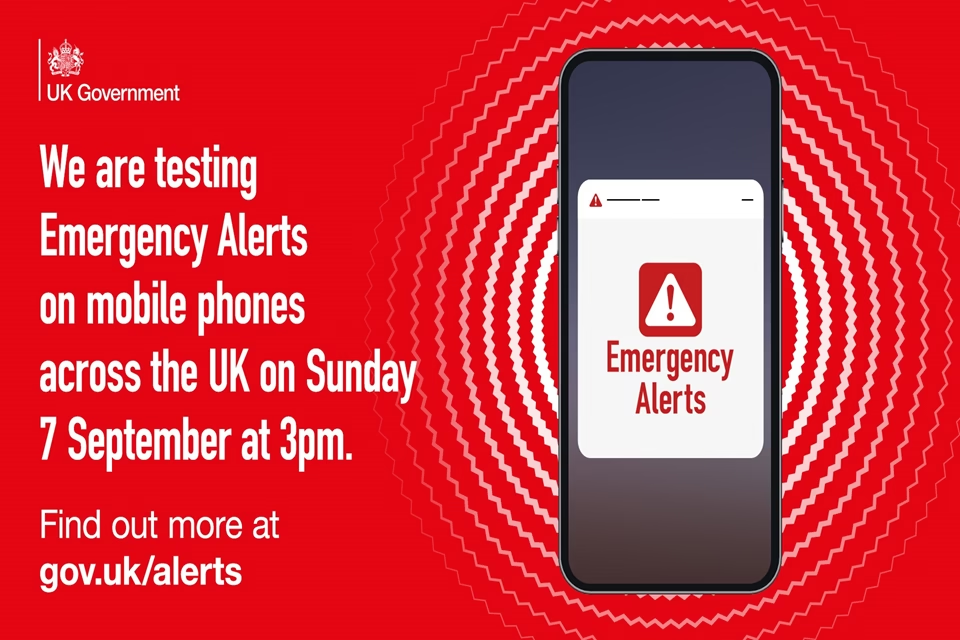
Introduction
The UK emergency alert system will undergo another nationwide test in September. This marks kia key step in strengthening the country’s readiness for emergencies. Designed by the UK government, the system instantly delivers life-saving warnings to mobile phones during disasters, terror threats, or extreme weather events. The upcoming emergency alert test ensures the system remains reliable, fast, and effective for all citizens.
In this blog, we explain what the UK emergency alert system is, why the government is testing it again, how it works, and what the public should expect
What Is the UK Emergency Alert System?
The UK emergency alert system is a national safety tool that sends urgent messages directly to mobile phones. Unlike regular SMS, it uses cell broadcast technology, which means everyone in a danger zone receives the alert at the same time, regardless of mobile network or internet connection.
Each alert includes:
A loud siren-like sound.
A phone vibration
A clear text message with instructions.
The alert overrides silent mode, ensuring everyone notices it immediately.
Why the UK Government Introduced the System
The UK government created the UK emergency alert system to protect the public during large-scale threats. Traditional channels like TV, radio, and social media cannot always reach people quickly or directly. This system solves that problem by targeting specific locations in real time.
The alerts help save lives during:
Terrorist incidents.
Severe flooding.
Wildfires and storms.
Other public safety threats.
By testing the system regularly, the government proves its commitment to national safety.
Why the UK Emergency Alert System Will Be Tested Again
The upcoming September emergency alert test marks another nationwide trial. The UK government wants to:
Test coverage across all regions.
Ensure all mobile networks respond correctly.
Educate the public on how alerts work.
Strengthen trust in the system.
This repeat test shows that the government treats emergency preparedness as an ongoing priority, not a one-time project.
How the UK Emergency Alert System Works September
The system sends alerts through mobile towers, not personal phone numbers. This design means:
1. Everyone in the affected area receives the alert simultaneously.
2. No personal data is collected or shared.
3. The system remains reliable even when networks are congested
For example, if severe flooding threatens a city, only people in that city will receive the alert. This prevents unnecessary panic while ensuring timely warnings for those at risk.
What to Expect During the September Test
The September emergency alert test will look and sound like a real alert but will clearly state that it is only a test. Citizens should expect:
A loud siren-like alarm on their phone.
A vibration lasting several seconds.
A message explaining that it is just a nationwide test.
No action is required during the test, but people should use the opportunity to discuss safety planning with their families.
Benefits of the UK Emergency Alert System
The repeat emergency alert test highlights the system’s many advantages:
Speed: Warnings reach millions within seconds.
Accuracy: Only people in affected zones receive alerts.
Reliability: Alerts work without Wi-Fi or mobile data.
Inclusivity: The loud sound and vibration help people with hearing or vision challenges.
Preparedness: Regular testing builds confidence and awareness.
The more familiar citizens become with the system, the more effective it will be during real emergencies
Common Concerns About the Emergency Alert System September
Some people raise concerns about privacy and daily phone use. Here are the facts:
Concern: The system tracks personal data.
Reality: The UK government does not collect personal information; it only broadcasts signals.
Concern: Alerts will disrupt phone calls.
Reality: Alerts appear during calls but do not disconnect them.
Concern: People can ignore alerts.
Reality: The unique sound and vibration are designed to grab attention instantly.
By addressing these worries, the government helps citizens feel safer about keeping alerts enabled
How to Prepare for the September Nationwide Test
Citizens can take a few steps to prepare:
Keep phones charged on test day.
Enable emergency alerts in phone settings.
Inform elderly relatives and children about what to expect.
Stay calm and remember it is only a test.
These actions will ensure a smooth nationwide trial and better preparedness for real emergencies.
FAQs
1. Why is the UK emergency alert system being tested again?
The September test helps the UK government confirm that the system still works effectively across all regions.
2. Will the test affect my mobile phone use?
No. The alert will appear briefly on your screen with sound and vibration but will not harm your device.
3. Do I need internet or mobile data for the alert?
No. The system uses cell broadcast technology, which works without data or Wi-Fi.
4. Can I opt out of receiving alerts?
Yes, but the UK government advises keeping alerts active for personal safety.
5. How often will nationwide tests September take place?
The government plans to test the system regularly to maintain reliability and public awareness.
Conclusion and Call to Action
The UK emergency alert system remains one of the strongest safety tools for protecting lives. The September emergency alert test proves the UK government’s dedication to public safety and readiness.
👉 Stay updated on the UK emergency alert system by subscribing to our blog.
📩 For collaborations, partnerships, or inquiries, contact us at: http://uk emergency alert system
SEO Tags
uk emergency alert system to be tested nationwide again in september
uk emergency alert system, uk emergency alert test september, uk government emergency alert, nationwide alert uk, uk mobile safety system, emergency warning uk, public safety alert uk
https://manyviral.com/can-trumps-big-beautiful-bill-pass-the-senate/
You might to like read this blog
Leave a Reply